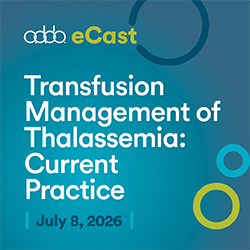

Product Code: 26EL-654-2035
Please note: This is a Single Viewer eCast registration for one participant for this eCast for both the live and on-demand version of this eCast. If you are interested in presenting this program to a group, please see the “eCast Registration Form– Group Viewing” form on the eCast program page.
Access instructions for the live eCast will be provided via email approximately 2-3 business days prior to the live program date. Access instructions for the on-demand version of this program will be provided via email approximately 3-10 business days after the live program has occurred and the on-demand version is available.
Program Description: The thalassemia syndromes constitute the most frequent inherited anemias managed with chronic red cell transfusion worldwide. The prevalence of thalassemia in the United States has increased with individuals exhibiting a wide spectrum of disease expression. The twin objectives of transfusion management of thalassemia are alleviating anemia and suppressing ineffective erythropoiesis. Transfusions are associated with the potential complications of iron overload, transfusion-transmitted infections, and alloimmunization. On the other hand, under-utilization of transfusion causes persistence of symptomatic anemia, hypersplenism, bone deformities, and poor quality of life. New transfusion guidelines that address the specific epidemiology and model of care of thalassemia in the U.S. have been published. This program will provide information on the pathophysiology and classification of thalassemia syndromes and the current clinical guidelines for chronic red cell transfusions, along with a patient-focused discussion of shared decision-making.